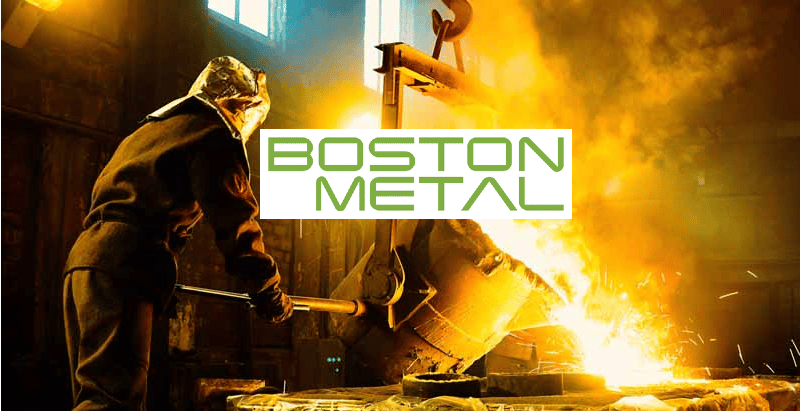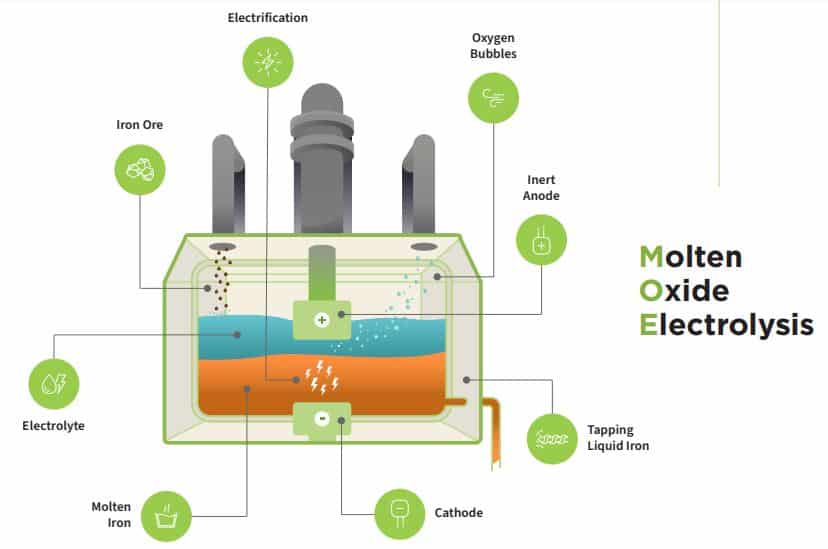The green steel technology firm that spun out of Massachusetts Institute of Technology (MIT), Boston Metal, raised $120 million in its latest funding round led by steel giant ArcelorMittal and participated by Microsoft.
The steel industry is raking in about $1.6 trillion in annual revenue. But that’s in exchange for 7% to 9% of the global carbon footprint, says the World Steel Association.
The industry is, in fact, the largest emitting manufacturing sector because it’s very reliant on coal to produce steel. And bringing it to net zero emissions by 2050 isn’t cheap – costing the industry between $215 to $278 billion.
But using green solutions to make clean steel can help reduce the cost. This is exactly what the MIT spinout company Boston Metal proposes through its unique electrolysis process. Its technology attracted large companies wanting to decarbonize the industry.
Ramping Up Boston Metal Green Steel
To meet the Paris Agreement, emissions from steel and other heavy industries have to fall by 93% by 2050. Hence, steel manufacturers need to reduce their emissions in large amounts.
Good thing MIT technology experts were able to show that it’s possible to make steel without emitting CO2. And that’s when they created a new company to scale the technology in 2013. Four years later, a steel industry veteran with four decades of experience, Tadeu Carneiro, became Boston Metal’s CEO.
In the next year, the tech company raised a $20 million Series A round led by Bill Gates’ climate investing firm Breakthrough Energy Ventures. In its latest funding, Boston Metal secured $120 million in a round led by steel giant ArcelorMittal. To date, it has raised a total of $220 million to support tech development.
ArcelorMittal’s VP Irina Gorbounova noted the EU Emissions Trading System (ETS) already puts a price on carbon emissions and that they expect other regions to follow. She said that:
“Zero or near-zero carbon emissions steel will become a reality. The only question is how quickly we can make that journey happen. If steel companies don’t decarbonize, they will not stand the test of time.”
Microsoft’s $1 billion investment arm Climate Innovation Fund also took part in the funding round. The fund supports ramping up the development of carbon reduction and removal technologies. The tech giant aims to be carbon negative by 2030 and hit net zero by 2050.
With its Series C funding, Boston Metal seeks to ramp up green steel production at its pilot Woburn, Massachusetts facility. The firm will also use the money in support of building its Brazilian subsidiary where it will manufacture various metals.
Making Steel Without Carbon Dioxide
In a traditional blast furnace steelmaking process, iron ore is combined with coal that’s baked and converted into coke. This process releases significant CO2 emissions via these ways:
- carbon in coke and limestone creates CO2 as a byproduct
- fossil fuels used to heat the blast furnace
- coal used to power plants and ovens releases CO2
Approximately 70% of the world’s steel is made that way, which generates 2 tons of CO2 for each ton of steel produced.
Boston Metal will change that with its patented “Molten Oxide Electrolysis” (MOE) process. It takes advantage of clean electricity to transform low-grade iron ore into high-purity molten iron.
This single-step method eliminates the need for secondary steel processing that emits CO2. So, there’s no CO2 involved but only includes common oxides such as silica, alumina, calcium, and magnesium. These “soup of other oxides” mix with the iron oxide where electricity passes to make iron and oxygen without producing waste.
But the availability of clean electricity will largely impact how fast the MOE process can be implemented by steelmakers. Otherwise, its purpose of “greening” steel production will be to no avail.
There are other alternative processes present to make green steel.
One is the green pig iron production processed using low emission technologies and inputs. It uses renewable input of biomass called biochar. Like MOE, it also eliminates the need for secondary processing like sintering and coking.
Another steelmaker is greening production by replacing coal with green hydrogen. This process will reduce CO2 emissions by over 90% compared to traditional steelmaking.
The Boston Metal’s CEO remarked:
“We believe in the future, we will have abundant and reliable and green and cheap electricity in order to use this process and manufacture green steel.”
Boston Metal will not be a steel manufacturer itself but will license its green technology to steel companies. Its MOE process has the potential to help steelmakers and the industry reach net zero emissions.
The company will start building its demonstration steel plant in 2024 and a commercial facility in 2026.


